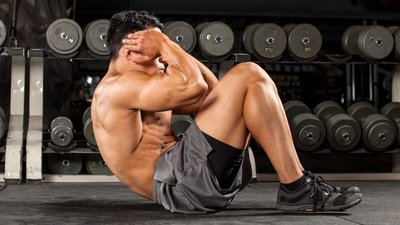Ab training is one of the most individualized activities in strength training. In the quest for that elusive rock-hard core with all the perfect bumps and ridges, gym goers engage in such a wide range of motions that it's hard to believe they all tie into the same goal. Some will hold the same position perfectly still for minutes on end, while others move in a flurry of elbows and knees. Some use weights, others machines, and plenty rely on nothing but gravity, leverage, and tension.
All of these people have obviously "solved" the six-pack conundrum, right? Far from it! On the contrary, I can almost guarantee that most gym goers—from the cable-crunching bodybuilder to the cardio warrior doing scissor kicks for dessert—could benefit from at least one of the following technique secrets.
So forget about diet and fat burning for a moment, read this list, and ask yourself, "Is my ab training up to snuff?" If you have a technique that you think is criminally neglected, let us know in the comments!
1. Round Your Back
You probably won't see those words anywhere else in a training article anytime soon. That's because you've rightly spent so much time learning how to keep your back flat—and locked in this position—when doing deadlifts, bent-over rows, squats, and other standing and bent-over exercises. The problem is that you need to unlearn that habit when training abs. Maintaining a flat or slightly arched back in the lumbar region in dynamic movements ensures the antagonist muscle—the abs—won't be able to fully contract in an active manner.
In fact, it's common to see individuals doing exercises like cable crunches and decline crunches with a flat back in which they're bending at the hips, not the waist. When you bend at the waist, you're able to fully crunch the rectus abdominis, meaning it shortens; at the same time, the lower-back musculature is being stretched. Maintaining a flat back and bending at the hips actually hinders your abdominal training because you can't fully contract your lower back and abs at the same time. All you get is an isometric contraction—which has value, but isn't what you're doing a crunch for.
Sure, a lot of pundits will tell you you're putting your lower back at risk by doing crunches at all, but they're overstating their case. That lingering lower-back soreness doesn't come from simple crunches, but more likely the same ab routine—any ab routine—over and over again for months and years at a time.
The lesson for you: Diversify! Your back is made to bend, so do your crunches if you want, but be sure to get out of the sagittal plane for some rotational and lateral ab movements as well.
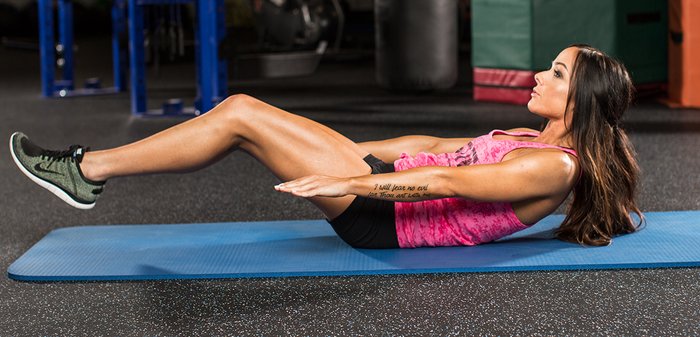
Your back is made to bend.
2. Target Specific Regions
Someone will inevitably comment that you can't isolate a portion of a muscle, such as the upper or lower portion of the rectus abdominis. They're only kinda right. Sure, pure isolation is impossible, but you can definitely emphasize one region over another, just as you'd focus on the upper pecs when doing incline benches.
Overall core strength and the transverse abdominis may be all the rage these days, but there's still value in knowing how to focus on the upper and lower areas so can create a routine that puts the focus where you want it.
To focus on the upper portion most directly, stabilize your lower body so that your hips hinge as you curl your upper body, bringing your ribcage towards your pelvis. A good example of an upper-ab move is the cable crunch, in which your lower body doesn't move. To better target the lower region, it's just the opposite: Your upper body is stabilized and you raise your legs up, which curls your pelvis up. A good example here is the hanging leg raise.
Some ab movements allow shortening at both ends, like a standard crunch, in which your rib cage and pelvis are moving toward each other, which effectively targets both the lower and upper abs. Oblique movements are ones in which you're twisting, rotating, or working in the lateral plane, such as when doing side bends. To hit your deep core—aka the transverse abdominis—include adequate heavy lifting and gravity-resisting movements like planks.
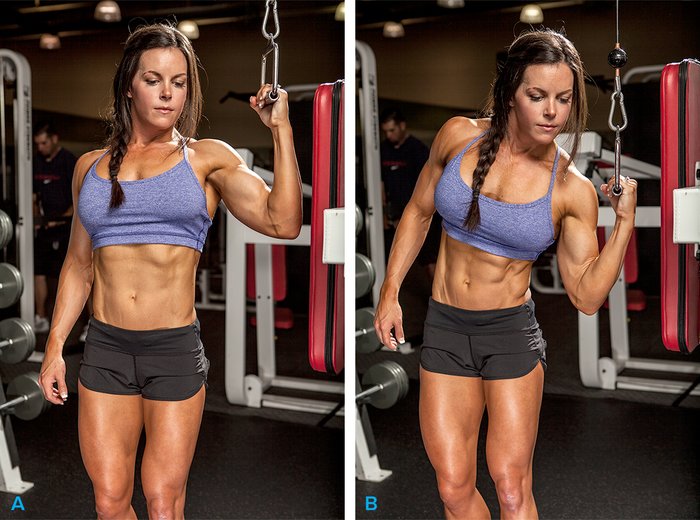
Pure isolation is impossible, but you can definitely emphasize one region over another.
3. Build Progression Into Your Training
You may think an ab workout consists of a handful of exercises, each done for 3 sets of 20. While that's certainly a workout, it isn't even close to being optimal.
Think about it: Do you go to the gym and always try to do the exact same weight for the same number of reps you did previously on squats? No—you work up to doing more reps, more weight, and more challenging variations. And when you reach one goal, you set another one.
Overload is the basis of building muscle and strength, and doing it consistently over time is the foundation of progressive overload. That's how you built up your big lifts, and it's the same approach you need to take with abdominal training.
Increasing the overload can include three factors:
- Increasing the resistance
- Doing more reps with a given resistance
- Decreasing your rest time between sets.
Strive to improve one of those variables at each workout rather than following a 3-sets-of-20 approach and calling it a workout. And every once in a while, change up everything you're doing and switch to a different set of movements entirely.
4. Start With A Weighted Move
The abs contain a greater percentage of slow-twitch muscle fibers than other skeletal muscle groups, but that doesn't mean you want to abandon the low-to-moderate-rep approach that best focuses on the fast-twitch fibers. In fact, fast-twitch fibers make up almost half of your midsection musculature.
To target the fast-twitch fibers and build up the ridges that comprise three-dimensional abs, start with weighted ab movements for lower reps, not unlike how you train other muscle groups. Choosing a weight that you can do for sets of 8-12 reps to failure is a good place to start. There are a number of options for you in the gym that allow you to use added resistance, including a variety of machines and cable crunches.
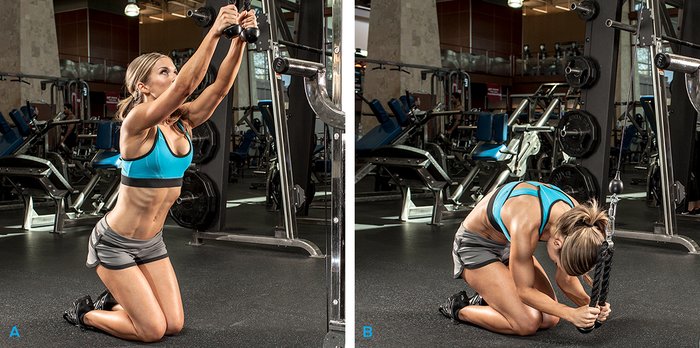
Cable Crunch
Conversely, you could use high-difficulty bodyweight movements where leverage and gravity are really working against you, such as ab roll-outs or TRX fall-outs. Yet another option is to increase the difficulty of any bodyweight exercises you can do for more than about 15 reps: Increase the angle of the decline bench on decline crunches, for example, or hold your arms straight over your head during sit-ups.
5. Hold The Peak Contraction
Lifting a weight is one thing, but holding it there takes the challenge to a new level. That's the concept behind peak-contraction training, which can be done for any body part, as you consciously squeeze the muscle at the end of the range of motion.
Compare a set of 20 crunches in which you merely raise yourself against one in which you hold the top position for a count. Still too easy? Try some hanging leg raises where you hold your legs straight for a second at the top. The latter is much harder.
Sure, you may end up doing far fewer reps at the end, but you'll make the muscle work harder, which is really what you want to be doing. Reaching a predetermined rep target shouldn't be your primary goal when it comes to ab training. Quality and difficulty of movements are, and always have been, more important!
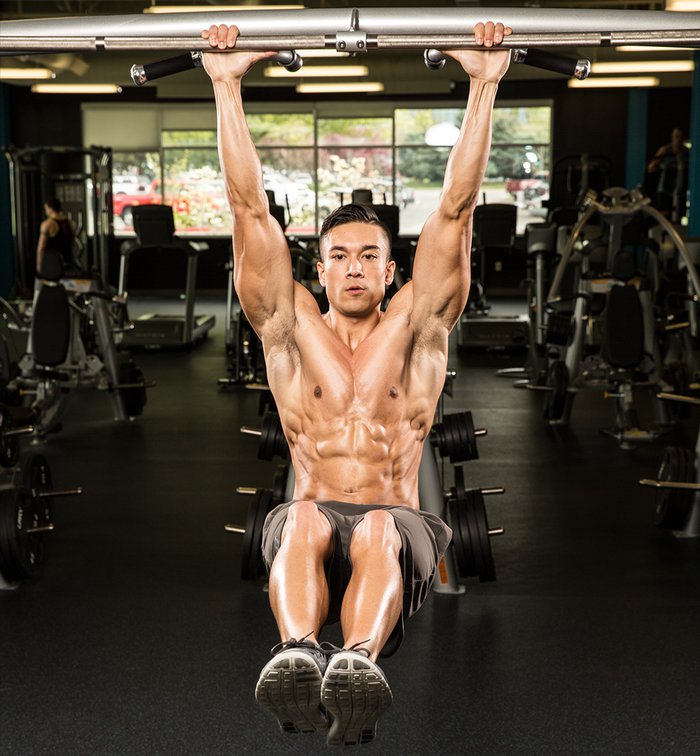
Lifting a weight is one thing, but holding it there takes the challenge to a new level.
6. Don't Rest Between Reps
When you're training with cables or machines, it's very easy to allow the plates to "touch down" between reps. When gravity wins like this, all the force you've generated at the end of the range of motion instantly dissipates, and the stimulus on the target muscle disappears.
While that's easy to see on a chest-press machine, it's less obvious on many ab exercises—especially bodyweight movements. During exercises in which you're lying on your back, keep your shoulder blades off the mat as you descend. Coming completely back essentially allows you to start the next rep from a resting position.
Again, making a movement harder may mean you don't reach a rep target, but on the other hand, consider that you're keeping tension on the muscle for the duration of the set, which improves the overall quality of the set.
7. Don't Let Your Hip Flexors Take Over
You've probably heard this one before, but what the heck does it mean? The hip flexors are a group of muscles that originate in the lower back and pelvic region, and insert on the upper region of the thigh. You can mistakenly work the hip flexors, thinking you're doing a lower-ab movement.
Here's how to tell whether you're working your lower abs: Hang from a bar, keeping your body straight. Now raise your knees up about 60 degrees. Notice how your lower back is still flat and hasn't started to round? That's a clue the lower abs aren't yet engaged. It's mostly hip flexors at this point, because they're responsible for raising your legs. Now continue raising your legs well past the point at which your thighs are parallel to the floor—as high as you can. That's when the abs really start to come into play.
Also, any time you anchor your lower legs or feet, as when doing decline-bench crunches or sit-ups, it's easy to "pull" through your upper thighs rather than using your abdominals to raise your torso up. That's a sure sign the hip flexors are heavily engaged during the movement. To deactivate your hip flexors during a traditional crunch, lift your feet off the ground, bringing your thighs to a 90-degree angle with your hips, and keep your shins parallel to the ground.
8. Make Everything A Plank
You've probably tried planks, in which you tense your abs and resist the urge to let your back sway for a set amount of time. But you don't have to be in a prone position to work your transverse abdominis. In fact, you can do any number of standing exercises while simultaneously doing a standing plank-like movement.
A number of strength coaches in recent years have pointed out that good form on a wide range of movements resembles the plank. A push-up is definitely a moving plank, for instance. Deadlifts and squats both resemble a plank at the top. Same for a safe overhead lift, and even a heavy, strict biceps curl. Pulling in your belly button will strengthen your core as you exercise, and over time it will become more natural for you.
Consciously tense up when doing all kinds of standing movements like press-downs, lateral raises, and shrugs.

Push-ups
Your weight belt can be your enemy here if it's tightened around your waist throughout your workout, so save it for your heavy sets. Not only will your core not likely be as active during some exercises with a belt on, it'll end up having the opposite effect of doing standing planks; you'll be more inclined to let go of your gut control.
Need a further endorsement? Franco Columbu, owner of some of history's best abs, didn't work them directly. Instead, he squeezed them hard during every other movement he performed.
Got it? Now go do it!



